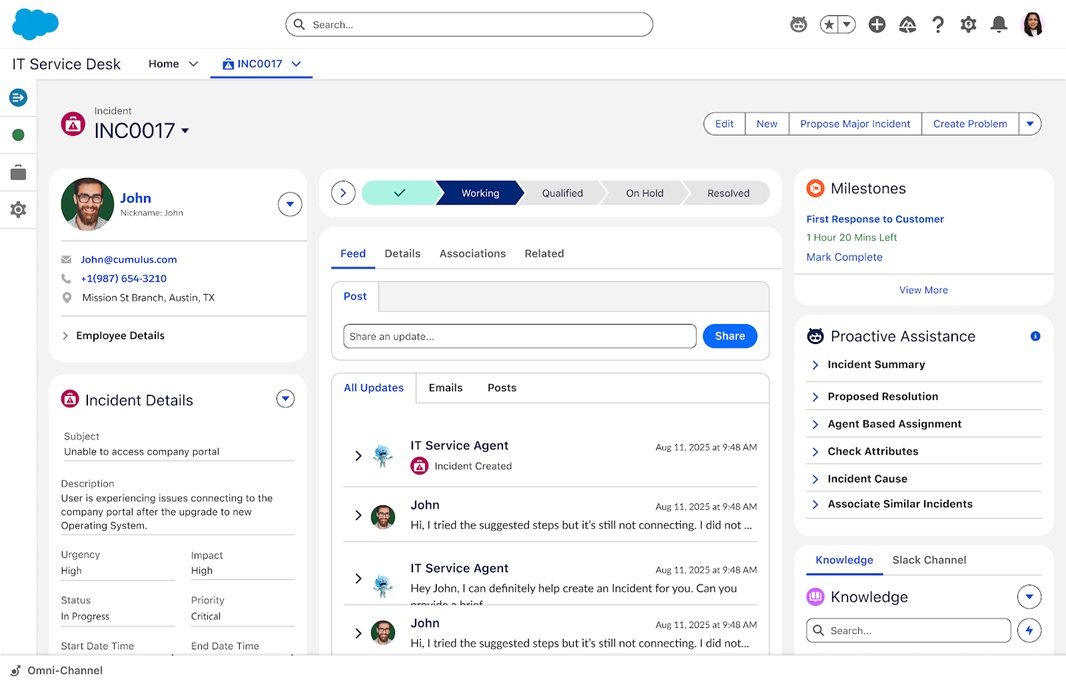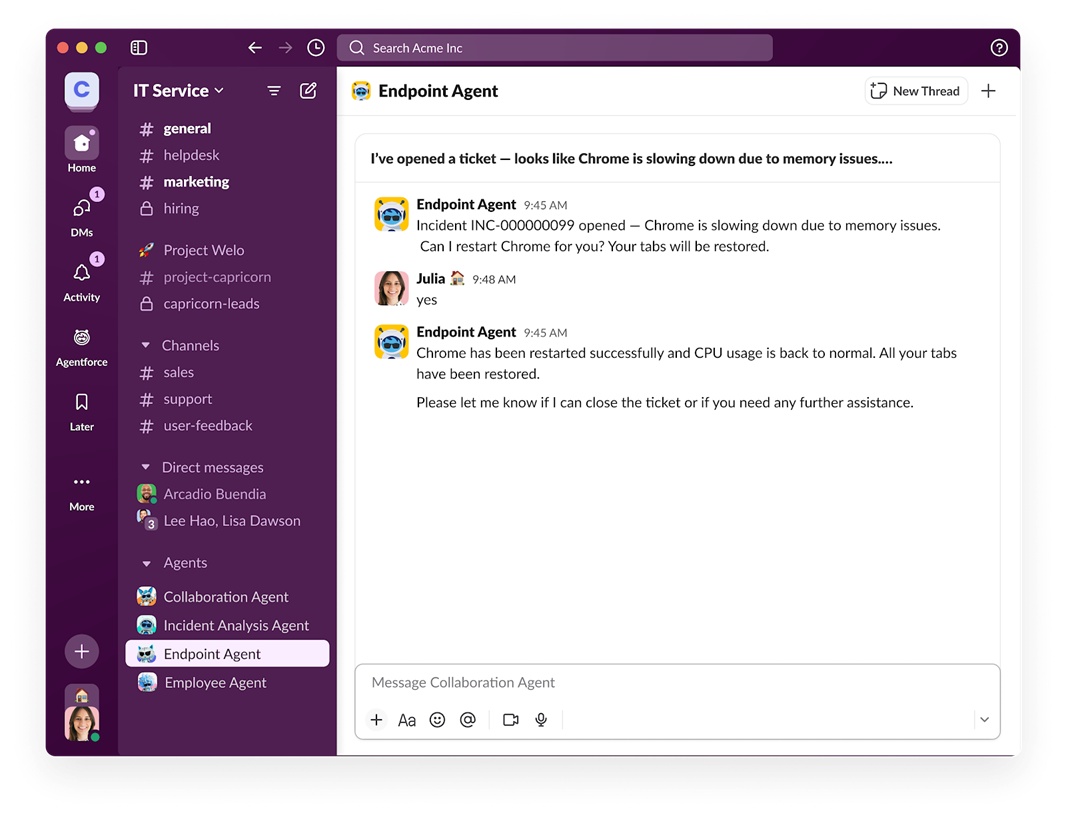Salesforce is making a remarkable move by adding IT Service Management to its portfolio. At Dreamforce, the company announced Agentforce IT Service, a complete ITSM solution built on the Agentforce platform. A surprising move, but is this a response to ServiceNow? According to SVP & GM IT and HR Service at Salesforce,Muddu Sudhakar, it is a logical extension for existing Service Cloud customers.
Nevertheless, the choice of ITSM is quite striking. Salesforce could also have opted for HCM, Finance or ERP, but deliberately chose IT Service Management. Sudhakar explains: “It’s a natural step. Customers who use Salesforce Service Cloud ask us: you do this so well for customer service, why not for IT service?”
Still, we can’t entirely separate it from ServiceNow, which has adjusted its strategy and focused heavily on the CRM market for the past two years, the category in which Salesforce was born. Salesforce is now suddenly focusing on ServiceNow’s flagship product, ITSM.
In addition, Salesforce launched Agentforce for HR Service earlier this year, which now has 180 customers. Three guesses as to what the second category is in which ServiceNow is strong, alongside ITSM: HR. In any case, the competition between Salesforce and ServiceNow is reaching a climax.
Sudhakar insists that IT Service is the next step in their service strategy. The company has been working on IT Service for 13 to 18 months. It wants existing Salesforce customers to use the platform they are used to from Service Cloud, but for ITSM. It’s time for us to find out how comprehensive Salesforce’s ITSM solution is, what sets it apart, and what customers can expect.
More than just an IT service desk
What Salesforce is launching is not a simple ticketing tool. The company is announcing a complete ITSM solution with four main components:
- IT Service Desk for incident, problem, change, and release management
- CMDB (Configuration Management Database) for managing all endpoints and devices.
- Discovery functionality via software agents in the organization’s network
- Service Graph for visualizing relationships between systems
“We offer a complete system of record for IT services,” Sudhakar emphasizes. The Discovery agents run in the customer’s network and collect information about all CIs (Configuration Items), their mutual relationships, and connectivity.

AI agents that perform actions
The main difference with traditional ITSM solutions lies in the AI functionality. Sudhakar is adamant about this: “This is not a knowledge base solution. Our agents work entirely on workflows, actions, and tools.”
The agents can actually perform actions such as resetting passwords, rolling back VPN configurations, and adjusting network drivers. For IT teams, it goes further: the agents analyze historical tickets through clustering, identify patterns that people would not see in a linear view, and propose solutions.
“People think linearly,” Sudhakar explains. “Here, we use agents and AI for non-linear thinking. We apply non-linear analysis to incident clustering to improve the productivity of IT teams.”

Hybrid approach: proprietary agents and partnerships
A crucial question for any cloud-based ITSM solution: how do you gain visibility into local networks and systems? Salesforce opts for a hybrid model.
For discovery, Salesforce places its own software agents in customers’ networks. These collect information about the IT environment. To perform actions and receive more telemetry, Salesforce integrates with over 100 partners.
“We have integrations with Microsoft Intune, Jamf, TeamViewer, and CrowdStrike,” Sudhakar summarizes. “Where partners are already present, we want to integrate with them for discovery and for executing actions.”
Currently, the Salesforce agent in the network is only used for discovery. When asked whether they will also perform actions in the future, he replies: “Stay tuned, we still have a lot to do.”
Humans and machines working together
Despite all the automation and AI, humans continue to play a crucial role. “We want people and agents to work together,” says Sudhakar. Users can escalate to a human agent at any time, and IT teams can also consult experts.
Security, trust, and guardrails are built in from the start. This applies to authentication, authorization, and role-based access management. “There is a human in the loop at every step,” he emphasizes.
Ambitious roadmap
Salesforce is looking beyond just service desk functionality. The roadmap includes:
- IT service domain packs
- 25+ out-of-the-box agents at launch
- Hundreds of workflows and connectors
- Multi-channel support: Slack (first), Teams (ready), Web Chat, WhatsApp
- Expansion to IT compliance and GRC
- Hardware, software, and IT asset management
Agentforce IT Service is not a small ITSM solution
Salesforce has already delivered a very comprehensive AI-based ITSM solution. The submission and processing of tickets is already as AI-based as possible. In addition, significant investments have been made to enhance telemetry and third-party integrations, making the solution more powerful. So we wonder how involved Salesforce wants to become in the ITSM market and how much it wants to rely on partners.
Sudhakar immediately makes it clear that we should not underestimate this. “This is not a small strategy,” says Sudhakar. “When we make such a large investment with hundreds of thousands of resources, we go all in.”
Salesforce has entered the ITSM market and is going all in. In addition to sales, service, marketing, commerce, and the like, there is now also ITSM, but under the name Agentforce IT Service. In the coming year, this solution will be further expanded to include hardware, software, and IT asset management.
HR Service moves from the experience layer to HCM
We would almost forget, because Salesforce also introduced Agentforce HR Service a few months ago. Something Sudhakar is also responsible for. According to him, we should see Agentforce HR Service as an experience layer on top of existing HCM systems such as Workday, SAP SuccessFactors, and Oracle. For a single HR request, the solution often has to address 16 different systems.
“We want to be the experience layer,” Sudhakar explains. “Your data is not only in Workday, but also in Kronos, ADP, QuickBooks. We offer multi-integration.”
The question is obvious: if you already have the experience layer, wouldn’t it be easy to also deliver the underlying HCM system? Sudhakar’s answer: “Stay tuned.” He does emphasize that Workday is a “great partner,” just like SAP and Oracle. But we also know that all these players are competing with each other more and more. Something that Workday’s CTO recently acknowledged.
Availability
Salesforce Agentforce IT Service was announced during Dreamforce and will be rolled out in phases. According to Sudhakar, the company is explicitly positioning the solution as a “state-of-the-art agent IT service” built for 2025, not as a “grandfather’s IT service desk.”
In the coming period, Salesforce will have to prove itself as a fully-fledged ITSM solution. Given the ambitious roadmap and Sudhakar’s words, Salesforce appears to be making a serious investment in ITSM. It is therefore more than just a superficial service cloud extension.
